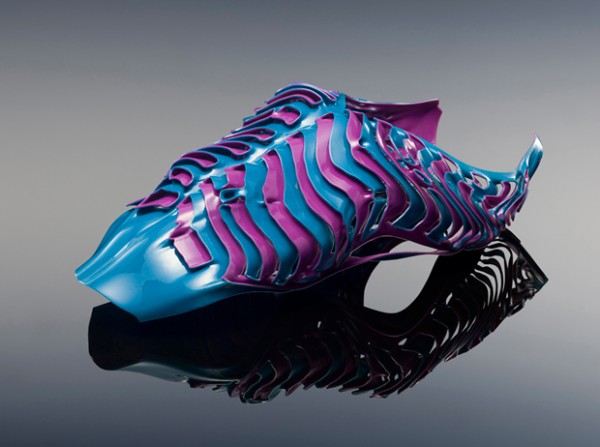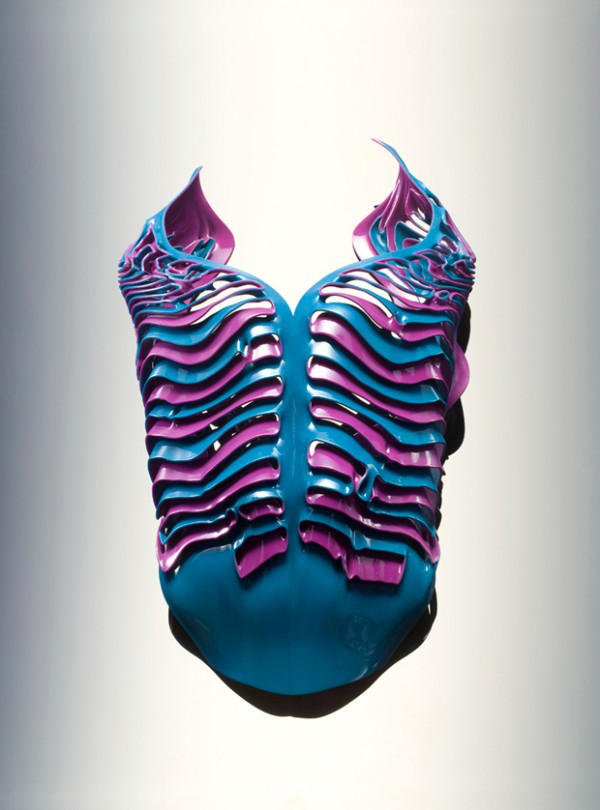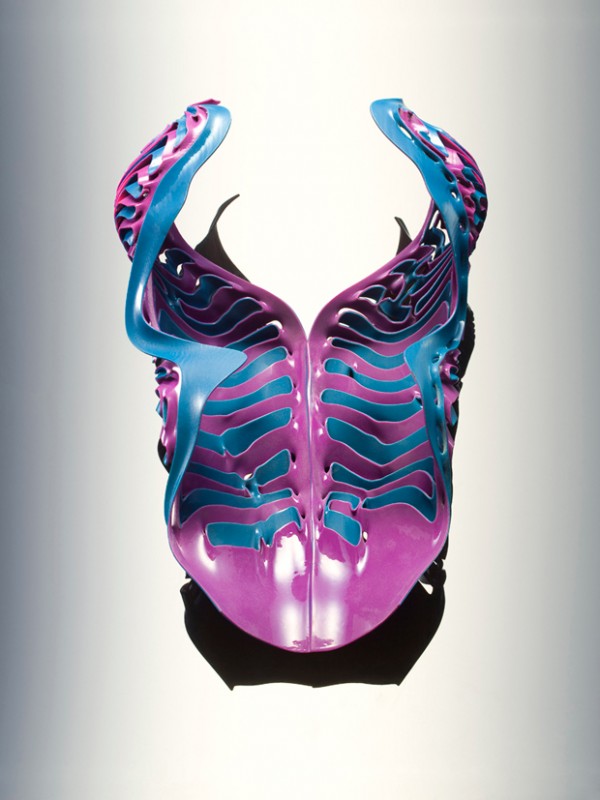The Leviathan as an ancient sea monster is mentioned six times in the Book of Job where it is described in detail. Among Job’s portrayal of Hell’s gatekeeper are numerous material depictions manifesting the creature’s physical traits which allow him to move speedily at sea despite its heavy build. His back has rows of shields tightly sealed together; Each is so close to the next that no air can pass between them; They are joined fast to one another; they cling together and cannot be parted; The folds of Leviathan’s flesh are tightly joined; they are firm and immovable; His chest is hard as a rock, ‘hard as a lower millstone’ (Book of Job). This underwater wriggling serpent is here re-imagined as armor for the human torso, inspired by the Leviathan’s anatomy and physiology. Composed of a thin stiff shell, cuts are introduced into the surface to allow for the flexibility required for movement and stretching. This body suit is designed as a single continuous surface with thin slots printed in two materials. Each slot is double-sided such that soft materials make up its internal composition providing comfort, while a stiffer material is deposited externally to provide for a protective outer shell.
Design: Neri Oxman in collaboration with W. Craig Carter (MIT) and Joe Hicklin (The Mathworks)
Photos: Yoram Reshef
Centre Pompidou Collection
Design and Mythology are both media for storytelling that represent general cultural truths and their human meaning. Like design, mythology is a universal language by which to decode human culture; and as in design, myths often employ the augmentation of human power in expressing the super-natural. Indeed, throughout the history of design, humans have attempted the unattainable. From Da Vinci’s human-powered aircraft as inspired by the wings of Icarus, to inventions of material self-repair and regeneration dating back to the myth of the Promethean liver, design has consistently dealt with amplifying human powers or compensating for human limitations. It is not surprising then, that mythological ‘beings’ are often portrayed as personifications of natural forces. Indeed, the myths that tell of these earlier gods fulfilled the role of explaining the existence of nature. The collection includes 18 prototypes for the human body inspired by Jorge Luis Borges’ Book of Imaginary Beings. An encyclopedia of fantastic zoology, the book contains descriptions of 120 mythical beasts from folklore and literature. Situated within and against the forces of nature, Borges’ bestiary provides the site for coupling the ‘cultural’ with the ‘natural’ in design, by designing a collection of nature-inspired human augmentations. Imaginary Beings : Mythologies of the Not Yet postulates that futuristic design afforded by technological advancements, is rooted in fantasy and in myth: from the Golem of Prague to robotic exoskeletons, from Daphne’s wings to flying machines, from Talos’ armor to protective skins; mythemes – the design kernel of the myth as defined by Claude Levi-Strauss – provide us with eternal archetypes of the super-natural and its material expressions. Each ‘being’ in this series encapsulates the amplification and personalization of a particular human function such as the ability to fly, or the secret of becoming invisible. What was once considered magic captured by myth, becomes actuality as design and its material technologies offer more than meets the skin: spider suits, wing contraptions, and ultra-light helmets; these are all what one may consider mythologies of the “Not Yet”. In projecting the future, this work makes use of new and innovative material technologies enhancing both the physical and environmental properties of these wearable myths and habitable contraptions. A library of algorithms inspired by form found in nature informs the design and fabrication process. Novel multi-material 3-D printing technologies along with new design features such as bitmap printing and property textures have been developed to support material performance and expression. Revealing nature’s design language, this collection of objects represents a library of design principles inspired by nature suggesting that the ancient myth and its futuristic counterpart unite where design fabrication recapitulates fantasy.

















